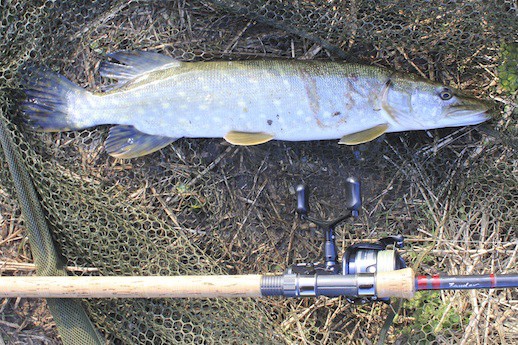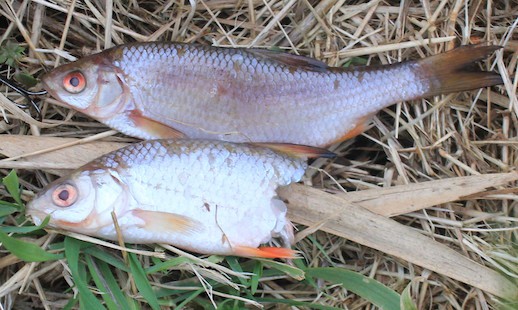The Lazy Wind
Words and pictures: John Richardson
In Fenland they describe the biting cold northerly based wind that we’ve been enjoying for the last month as ‘The Lazy Wind’; as the farmer at one of my favourite pike fishing venues said, ‘it’s a lazy wind, it can’t be bothered to go round you so it just goes straight through you’. Having experienced week after week of it since the turn of the year I know exactly what he means, it is definitely an accurate description.
Going pike fishing in the winter in the seemingly bleak fenland landscape is like entering another cold world. Particularly when you carefully traverse the sloping, frozen grassy banks of the drains to get down to the waterside and then push the frozen dead rushes to one side to begin fishing, it’s crackle and crunch until the bait is in the water then the sound of the wind returns.
Only the military jets and distant tractors break the natural sounds of the fen, but when the fen quiet does descend it isn’t really a silence at all. If you listen carefully you will hear the rustlings of small lives and hear the kingfisher, even if you don’t see him, as he travels like a blue tracer bullet along the drain.
Two seasons ago I concentrated on fishing estate lakes but the antipathy of other anglers towards pike which they described as a nuisance fish, the ‘move them into that lake if you get one mate’ attitude, made me change tack. They are part of the ecology of the waters, with a right to be there at the top of the food chain and those lakes where they have been removed are now swarming with pike bait but with very few pike to maintain the balance.
I decided that a change in direction and tactics was called for, a change that meant fishing the wild places out on the fen, and this environment has gradually worked its way under my skin and into my heart; I just love winter in Fenland. In summer it’s the land of the reed warbler and in winter duck, geese, swans, crows, fieldfares, pigeons, plover, tern, egret, heron and LBJ’s. What’s an LBJ? What the farmers call a whole class of small birds that fall into the category of ‘Little Brown Jobs’, so now you know.
The change in direction has demanded new tactics and rather than set up a camp and stay in one place to fish I now travel light with one rod, one landing net, some traces and of course, bait and I now slowly work my way along a mile of bank in two or three hours. There are periods when you feel that there isn’t a fish anywhere as you gently twitch the dead roach back along or just above the bottom of the drain. Then fifty yards away fry and baitfish burst out of the water in a great commotion of splashing and swirling, and that area is marked for some serious attention when you get there.
Fishing close to or on the bottom you do snag dead weed but your senses rapidly adjust and learn what that feels like and what is happening at the sharp end. At others times the line vibrates gently like a long thin tuning fork and you know that deep down in the dark water something has mouthed the bait and stopped with their prize gripped firmly in those toothy jaws.
At this point there is a sense of fear, excitement and trepidation because under the water just how big is this fish that has taken the bait so gently? Is it a jack pike or something very much bigger? A couple of sharper twitches vibrate up the line as the pike turns the bait in its mouth, this is the time to strike, and hopefully find out just how big the pike is as the fish begins to move away.
A few weeks ago I was playing a pike of around six or seven pounds and the fish on my line was, in turn, grabbed by another larger pike that finally decided let go. The second pike left clear bite marks on both flanks of my fish when it was landed. Anglers say that a pike’s only enemy is a bigger pike, so as a pike there you are at the top of the food chain but you are in a new pecking order where your position is determined by size and a little cunning.
That there are very big fish in the drains is without doubt, having caught a twenty seven pound pike last season I saw a pike in one of the drains this year that was much bigger, and I do mean much bigger as in well over thirty pounds; just basking in the weak sunlight next to the brown reeds. A dead roach cast temptingly in front of it was ignored and the fish just drifted slowly down and disappeared into the depths. I haven’t seen it since but I live in hope. Or perhaps not, particularly if darkness is drawing in.
There is, however, no predictability in the way a pike takes the bait, some times they follow and make a swirling lunge just as the bait is lifted from the water. Sometimes there is just a massive pull and half the bait is all you have remaining on the hook; the tail end having been cleanly bitten off. At other times they are as gentle as a trout sipping down a dry fly.
Between now and the end of the season on March 15 I have permission to fish two drains where the farmer allows nobody to fish or shoot on his land, that heightens the expectations and excitement.
Meanwhile I’ll be out on the Fen chasing pike in the ‘lazy wind’ or, if you prefer Bob Dylan’s lyrics describing hard winds take your pick from ‘Chilly wind sharp as a razor blade’’ or an ‘Englishman stranded in the blackheart wind’ as alternative descriptions for winds from the icy cold northerly quadrant.
Whichever you prefer I wouldn’t want be pike or perch fishing anywhere else, but the perch fishing is another story for another day.
Zanderland archive

